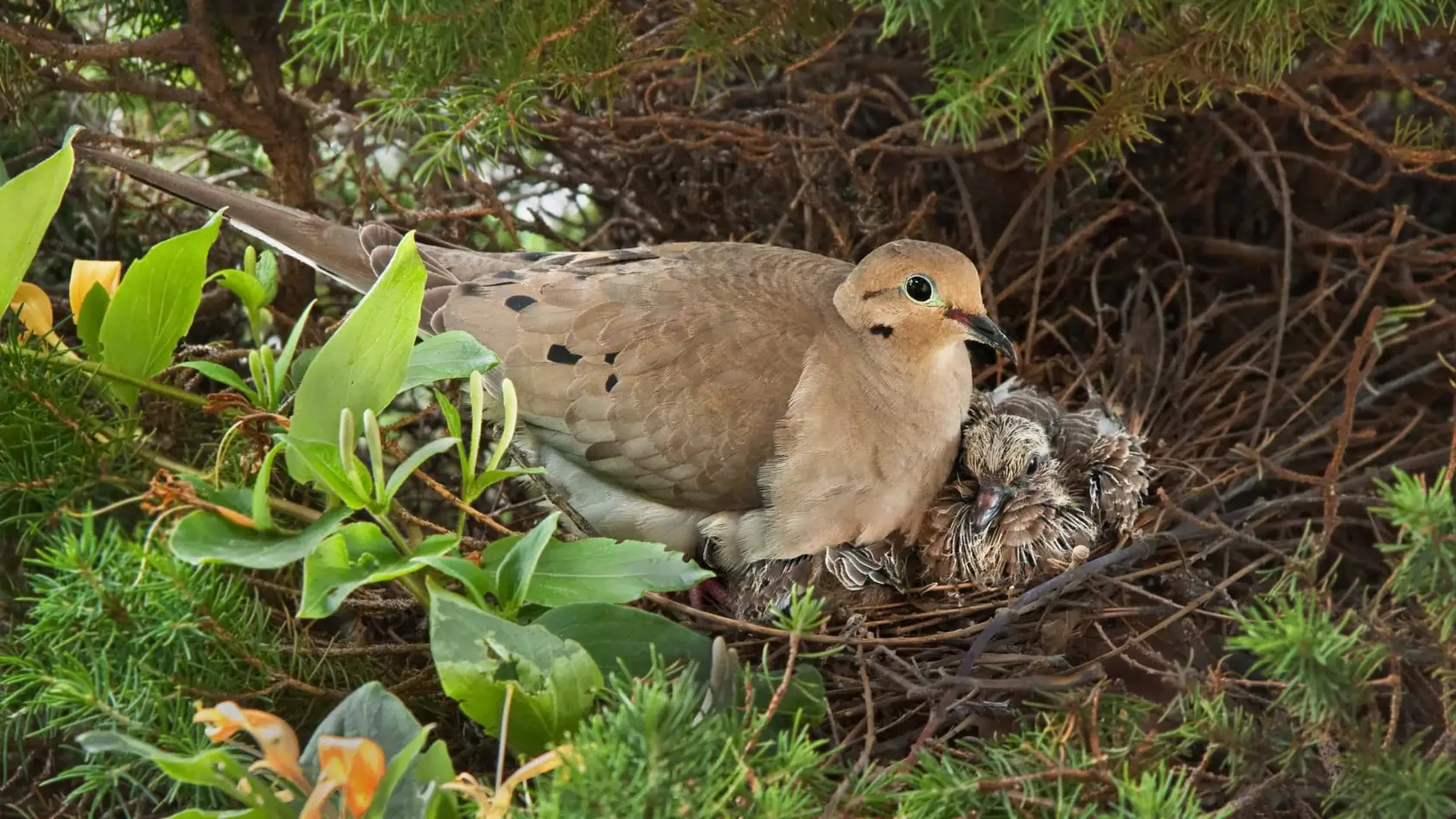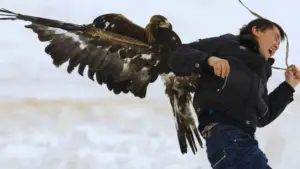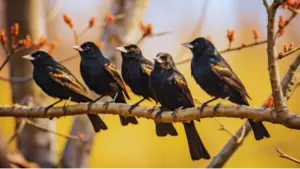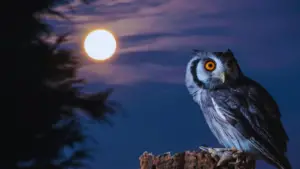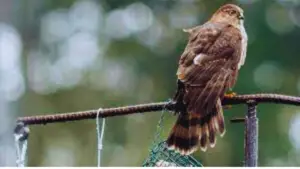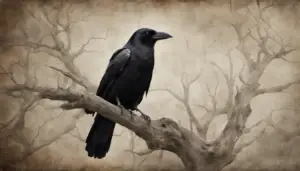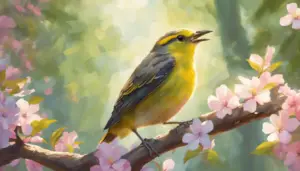How Long Do Birds Stay In The Nest? Learn About the Nesting Habits of Popular Bird Species and the Factors That Affect Nesting Duration. Discover Tips for Supporting Nesting Birds and Ensuring Their Survival. Read on for Expert Insights and Advice on All Things Bird Nesting.
Imagine a world where tiny creatures emerge from fragile shells, entirely dependent on their parents for survival. In this captivating journey, you will explore the wonders of avian nesting, uncovering the secrets of how long birds stay in their nests before embarking on a life of independence.
From the moment an egg is laid until the fledgling takes its first flight, the nest becomes a bustling hub of activity, filled with parental care, growth, and social interactions. You will witness the intricate dance of feeding and nurturing as the hatchlings develop and prepare for their grand departure.
Delve into the factors that influence their timing and discover the crucial role that nesting habitats play in their survival.
With a glimpse into migration patterns and conservation efforts, this article will leave you in awe of the remarkable journey birds undertake as they spread their wings and venture into the world.
Key Takeaways
- Nesting duration varies among different bird species, with some leaving the nest within 24-48 hours and others staying for weeks or months.
- Factors such as nesting habitats, weather conditions, and food availability influence the timing of birds leaving the nest.
- Birds employ various strategies to protect their nests from predators, including physical adaptations, behavioral defenses, and social interactions within the nest.
- Conservation efforts, including preserving nesting sites and reducing human-induced threats, are crucial for the future of bird populations.
The Nesting Process: From Egg to Hatchling
The journey from egg to hatchling is a mesmerizing process, filled with anticipation and wonder. As a bird, you start your life as an egg nestled snugly in a warm and cozy nest. Your parents carefully tend to you, keeping you safe and warm. Inside your egg, you slowly develop and grow, nourished by the yolk that surrounds you.
After a period of time, you start to feel the urge to break free from your shell. You use your beak to peck at the shell, creating a small hole. With each peck, you become more determined and excited. Eventually, you manage to crack open the shell, and a tiny beak emerges. You wiggle and push until you are completely free, taking your first breath of fresh air.
Now, as a hatchling, you are vulnerable and dependent on your parents for food and protection. They diligently feed you a diet of insects and worms, ensuring you grow strong and healthy. You spend your days nestled in the safety of the nest, growing and developing your feathers.
The journey from egg to hatchling is a truly remarkable one. From the moment you crack open your shell, you embark on a path towards independence. With the love and care of your parents, you will soon be ready to spread your wings and take flight, exploring the world around you.
Parental Care and Feeding
With a loving touch, bird parents tirelessly nourish their young, guiding them towards self-sufficiency. From the moment the hatchlings emerge, the parents are solely responsible for their care and feeding. They diligently search for food, often flying long distances to gather enough sustenance to satisfy the insatiable appetites of their growing chicks.
In the table below, we can see the types of food that different bird species provide for their nestlings:
| Bird Species | Food Provided |
|---|---|
| Robins | Insects, worms, and berries |
| Sparrows | Seeds, insects, and fruit |
| Hummingbirds | Nectar and small insects |
| Eagles | Fish, small mammals, and birds |
As the nestlings grow, the parents adjust their feeding techniques. Initially, they regurgitate food directly into the chicks’ mouths. As the chicks become more capable, parents will bring whole prey items to the nest, allowing the young birds to practice tearing and consuming food on their own.
Parental care and feeding continue until the nestlings are ready to fledge. At this point, they have developed the necessary skills and strength to venture out of the nest and explore the world on their own. It is a bittersweet moment for the parents as they watch their offspring take flight, knowing that their hard work has paid off in raising independent and self-reliant birds.
Growth and Development in the Nest
From the moment they hatch, bird parents tirelessly nurture their young, guiding them towards self-sufficiency in the nest. The growth and development that takes place during this time is truly remarkable.
As a baby bird, you will rely on your parents for everything – warmth, protection, and most importantly, food.
In the beginning, you will be completely helpless, relying on your parents to bring you a steady supply of insects, seeds, and other nourishment. They will tirelessly hunt and gather, ensuring that you have enough sustenance to grow strong and healthy.
As the days go by, you will start to grow rapidly, your feathers slowly replacing the downy fluff that once covered your body.
During this time, your parents will also teach you important life skills. They will show you how to preen your feathers, which helps to keep them clean and in good condition. They will also guide you in the art of flying, encouraging you to flap your wings and take short flights within the safety of the nest. These practice sessions will help build your strength and coordination, preparing you for the day when you will take your first flight into the world.
As you continue to grow and develop, your parents will gradually reduce the amount of food they bring to the nest. This is done intentionally, to encourage you to become more independent and start exploring the world outside. Eventually, the day will come when you are ready to leave the nest and begin your own journey towards adulthood.
In conclusion, the growth and development that takes place in the bird nest is a truly fascinating journey. From the moment of hatching, bird parents dedicate themselves to nurturing their young and preparing them for independence. Through their guidance and care, baby birds learn important skills and develop their physical strength. It is a remarkable process that ultimately leads to the moment when they take their first flight and venture out into the world on their own.
Fledging: The First Flight
Ready to spread your wings and take flight for the very first time? Fledging is an exciting and crucial moment in a bird’s life. It marks the moment when they leave the safety of their nest and venture into the world. This journey to independence is filled with challenges and opportunities for growth.
As a young bird, your first flight can be both exhilarating and terrifying. You may feel a mix of excitement and nervousness as you prepare to leave the comfort of your nest. Your wings, which have been growing stronger and more developed, are now ready to carry you through the air. With a few flaps and a leap of faith, you launch yourself into the sky.
During your first flight, you may experience a range of emotions. It’s normal to feel a bit unsteady and unsure at first. But as you gain confidence and practice your flying skills, you’ll become more comfortable in the air. Your parents will likely be nearby, watching and guiding you, ready to offer support if needed.
The first flight is just the beginning of your journey to independence. It’s the moment when you truly start to explore the world around you. As you continue to grow and gain experience, you’ll become more skilled and independent in your flying abilities. So, spread your wings and embrace this exciting new chapter in your life. The sky’s the limit!
Factors Influencing Nest Departure
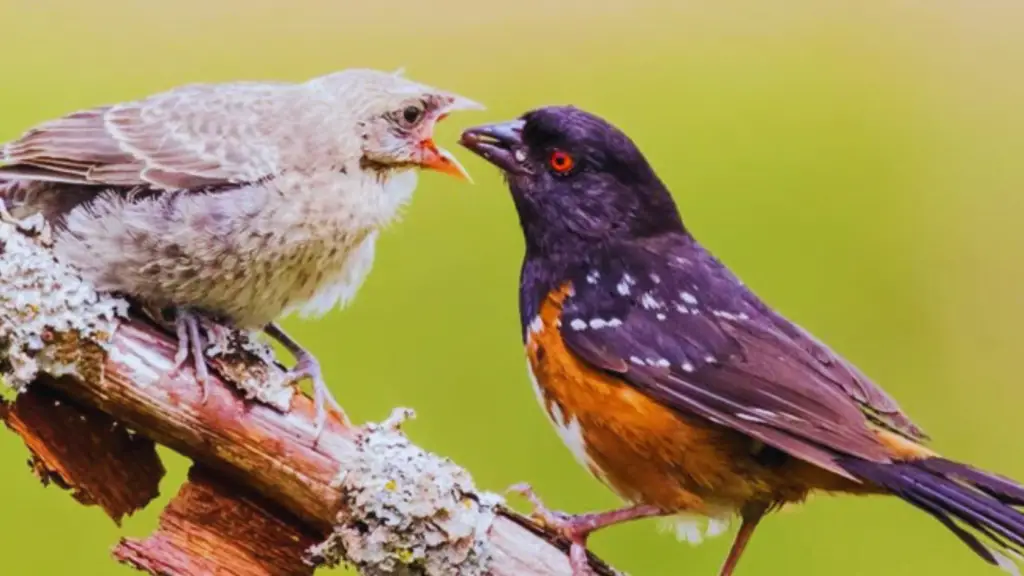
One of the factors that can influence when young birds leave their nests is the availability of food sources. As they grow, birds need a constant supply of food to fuel their development and prepare them for their first flight. The presence of abundant and easily accessible food near the nest can encourage young birds to stay longer, allowing them to strengthen their flight muscles and acquire the necessary skills for survival.
However, the availability of food is not the only factor that influences nest departure. Other important factors include the development of the bird’s feathers and wings, as well as their overall physical and cognitive abilities. Some bird species may leave the nest earlier if they have faster growth rates or if they are more precocial, meaning they are born in a more advanced state and can fend for themselves sooner.
To further understand the factors influencing nest departure, let’s take a look at a table that compares the average nest departure age for different bird species:
| Bird Species | Average Nest Departure Age |
|---|---|
| Sparrow | 10-14 days |
| Robin | 14-16 days |
| Eagle | 60-75 days |
| Penguin | 60-90 days |
| Albatross | 120-140 days |
By examining these averages, we can see that there is a wide variation in the time young birds spend in their nests before becoming independent. This variation is influenced by a combination of genetic, environmental, and ecological factors that differ among bird species.
Species Variations in Nesting Duration
The duration of time that young birds spend in their nests before becoming independent varies significantly among different bird species, creating an intriguing diversity in their development and readiness for flight.
Some bird species, such as ducks and geese, have a relatively short nesting period, with their young leaving the nest within 24 to 48 hours after hatching. These precocious species are born with downy feathers and are capable of walking, swimming, and feeding themselves almost immediately.
On the other hand, many songbirds, such as robins and sparrows, have a longer nesting period. These altricial species are born naked and helpless, relying completely on their parents for warmth, protection, and food. They spend an average of 10 to 14 days in the nest before they fledge, or leave the nest. During this time, the parents work tirelessly to feed their growing chicks and teach them essential skills, such as flying and foraging.
Other bird species, like raptors and owls, have an even longer nesting period. Their young can stay in the nest for several weeks or even months, depending on the species. These birds of prey have a slower rate of development and require more time to grow and acquire the necessary skills for survival in the wild.
In conclusion, the length of time that birds stay in the nest before becoming independent varies greatly among different species. This variation reflects the diverse strategies that birds have evolved to ensure the survival and success of their offspring in their respective environments.
Predator Threats and Nest Survival
Now that you understand how different bird species have varying nesting durations, let’s delve into the fascinating world of predator threats and nest survival. It’s a perilous journey for these tiny creatures as they strive for independence.
Birds face numerous predators during their time in the nest, ranging from snakes and raccoons to squirrels and even other birds. These threats pose a constant danger to the fragile eggs and vulnerable nestlings. However, despite the challenges, many bird species have developed remarkable strategies to protect their nests and increase their chances of survival.
In this battle for survival, birds employ a variety of tactics. Here are two sub-lists that will shed light on their ingenious strategies:
Physical adaptations:
- Camouflage: Some birds build their nests in such a way that they blend seamlessly into their surroundings, making it difficult for predators to spot them.
- Nest concealment: Birds often select hidden or hard-to-reach locations for their nests, such as dense shrubs or high tree branches, to minimize the risk of detection.
Behavioral defenses:
- Distraction displays: When predators approach, certain bird species will feign injury or perform elaborate aerial displays to divert attention away from their nests.
- Mobbing behavior: Birds will band together to harass and intimidate predators, sometimes even attacking them en masse to protect their young.
Witnessing these incredible strategies in action is a testament to the resilience and resourcefulness of birds as they navigate the dangerous path to independence.
Social Interactions in the Nest
Witnessing the incredible social interactions within the nest is like observing a bird community in action. As a fledgling, you are not alone in the nest. You have siblings that are your constant companions. Together, you spend your days huddled close, chirping and flapping your wings in excitement. These interactions serve an important purpose – they help strengthen your muscles and coordination, preparing you for the day when you will take flight.
Within the nest, there is a hierarchy, with the eldest sibling often taking the lead. You watch in awe as your older brother or sister asserts their dominance, ensuring that everyone gets their fair share of food. There is a constant chatter and movement as each bird jockeys for position, eager to be at the front of the line when the next meal arrives.
You also witness moments of playfulness and bonding. Siblings engage in mock battles, hopping and pecking at each other in a friendly manner. These interactions not only provide entertainment but also help build social bonds within the family unit.
As the days pass, you notice that the interactions within the nest change. Feathers become more ruffled, and tensions run high. It is a sign that it is time for you and your siblings to leave the nest and venture out into the world. The social interactions within the nest have served their purpose – they have prepared you for independence. With a mixture of excitement and trepidation, you take your first leap into the unknown, ready to explore the skies on your own.
The Role of Nesting Habitats
Nesting habitats play a vital role in the survival and reproduction of bird species, with studies showing that up to 70% of bird species rely on specific types of habitats for nesting purposes. These habitats provide the necessary shelter, protection, and resources for birds to successfully raise their young.
| Nesting Habitat | Description | Examples |
|---|---|---|
| Trees | Trees offer a safe and elevated location for birds to build their nests. They provide protection from predators and inclement weather. | Robins, woodpeckers, and eagles are just a few examples of birds that commonly nest in trees. |
| Shrubbery | Shrubs provide dense coverage and protection, making them ideal nesting spots for small birds. They offer camouflage and security from predators. | Sparrows, wrens, and finches are known to build their nests in shrubs. |
| Grasslands | Open grasslands provide ample space for ground-nesting birds to construct their nests. The low vegetation offers camouflage and easy access to food sources. | Meadowlarks, killdeer, and quails are commonly found nesting in grasslands. |
Understanding the specific nesting habitats preferred by different bird species is crucial for conservation efforts. By preserving and restoring these habitats, we can ensure the continued success and independence of bird populations. So next time you see a bird’s nest, remember the important role that nesting habitats play in their fascinating journey to independence.
Migration and Nesting Patterns
As you watch the vibrant colors of the sky transform into a tapestry of hues, imagine the awe-inspiring sight of flocks of birds soaring through the air, guided by their innate sense of direction, to reach their desired nesting destinations. Migration plays a crucial role in the nesting patterns of birds, as it allows them to find suitable habitats for breeding and raising their young.
During migration, birds travel long distances, sometimes crossing entire continents or even oceans. They rely on a combination of celestial cues, landmarks, and magnetic fields to navigate their way. Once they arrive at their chosen nesting grounds, birds begin the process of building their nests, providing a safe and secure environment for their eggs and future offspring.
The length of time birds stay in the nest varies depending on the species. Some birds, like ducks and geese, may only spend a few weeks in the nest before their young are ready to leave. Other birds, such as eagles and albatrosses, have longer nesting periods that can last several months.
During this time, parent birds diligently care for their chicks, providing them with food, protection, and teaching them essential survival skills. As the young birds grow and develop, they gradually gain independence and eventually leave the nest to start their own journeys.
Witnessing the migration and nesting patterns of birds is truly a remarkable experience. It reminds us of the incredible resilience and adaptability of these creatures, as they navigate vast distances and create nurturing homes for their young.
So next time you see a flock of birds overhead, take a moment to appreciate the incredible journey they have embarked upon.
Conservation and Protection Efforts

Efforts to conserve and protect bird populations have become a pressing priority to ensure the preservation of their vibrant and valuable presence in our ecosystems. With their diverse species and unique ecological roles, birds play a crucial part in maintaining the delicate balance of nature.
Conservation organizations around the world have been tirelessly working to safeguard bird habitats and combat threats such as habitat loss, climate change, and pollution. By creating protected areas, implementing conservation plans, and raising awareness, these efforts aim to secure the future of bird populations.
One of the key strategies in bird conservation is the preservation of nesting sites. Nesting habitats provide birds with essential shelter, protection, and a safe environment to raise their young. Some species rely on specific types of vegetation or structures for nesting, making their conservation crucial.
To further aid bird populations, conservationists also focus on reducing human-induced threats. This includes promoting responsible tourism, minimizing pollution, and advocating for policies that prioritize bird protection.
Conservation and protection efforts have shown promising results in many regions. By actively engaging communities, researchers, and policymakers, we can ensure that birds continue to thrive and contribute to the biodiversity of our planet.
Together, we can make a difference and secure a future where our skies are filled with the vibrant colors and melodious songs of birds.
How Long Do Birds Stay In The Nest FAQs
What are the different types of nests that birds build?
Birds build different types of nests such as cup nests, platform nests, cavity nests, and pendulous nests. These nests provide shelter and protection for eggs and chicks, ensuring their survival and growth.
How do birds choose their nesting site?
Birds choose their nesting site based on several factors, including safety, availability of food, and proximity to water sources. They carefully assess potential locations, weighing the advantages and disadvantages before making a decision.
Do all bird species lay eggs in nests?
Not all bird species lay eggs in nests. Some birds, like the brood parasites, lay their eggs in the nests of other birds, tricking them into raising their young. It’s a clever survival strategy.
Are there any bird species that stay in the nest longer than others?
Some bird species stay in the nest longer than others. The duration of nest stay varies depending on the specific bird species and their developmental needs.
How do birds protect their nests from predators?
Birds protect their nests from predators by building them in hidden or hard-to-reach places, using camouflage and nesting materials that blend in with their surroundings, and by fiercely defending their nests when predators approach.
Conclusion
Congratulations on completing this fascinating journey into the world of bird nesting! You’ve learned that the time birds spend in their nests varies depending on factors such as species, parental care, and habitat.
Now, armed with this knowledge, you can appreciate the incredible journey birds go through to gain their independence. So, next time you spot a nest or witness a bird taking its first flight, remember the dedication and effort it took for them to reach that moment.
Happy birdwatching!

